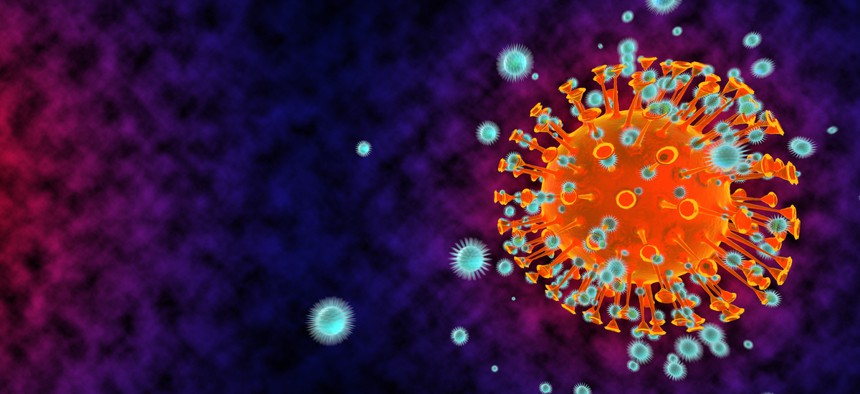Walter Reed Scientists Use Artificial Intelligence to Screen Drugs to Potentially Treat COVID-19

kittipong053/Shutterstock.com
The Experimental Therapeutics Branch accelerated its research by turning to machine learning, AI and high-performance computing.
Developing new drugs is costly, complex and generally takes years to reach a point where novel treatments are ready to be validated by clinical tests—but scientists within the Walter Reed Army Institute of Research turned to high-tech tools to more rapidly funnel out drug compounds that could effectively target COVID-19.
“Rightfully, the people of the United States and the world want an answer fast,” Deputy Director of the institute’s Experimental Therapeutics Branch Maj. Brandon Pybus told Nextgov during a recent virtual panel. “So we looked into ways that we could shave time off of the front end of the drug discovery process, which can be pretty lengthy when it takes its normal course, because you, of course, have to not only prove that the drugs that you're developing are safe, but you have to prove that they're effective—and then they have to clear all of these regulatory paths.”
The Experimental Therapeutics Branch holds significant clout as a drug discovery and development program, including having a hand in every Food and Drug Administration-approved malaria prevention drug. As the pandemic emerged, Pybus said inside officials opted to partner with Southwest Research Institute, which had developed what he deemed “a really interesting and novel machine learning- and [artificial intelligence]-based approach to find molecules that can successfully bind to a target of interest in the virus.”
The Experimental Therapeutics team had identified rare, derived structures of the spikes on the surface of the novel coronavirus that are responsible for attaching and invading cells. Researchers shared them with SRI to try to use AI and machine learning to screen through a very large number of compounds that they “threw at the spikes” to see if they would bind in the virtual space to inhibit attachment. But the team hoped to confront 41 million compounds, a computationally intensive number that ultimately warranted the support of a supercomputer to more quickly puzzle out those with the possibility to be effective.
Pybus and his team turned to the Defense Department’s High-Performance Computing Modernization Program, which he noted is essentially the Pentagon’s portal into all-things supercomputing. With the group’s publicly-provided resources, which are also being offered up to the U.S.-led high-performance computing consortium, Pybus and the team were able to swiftly screen those millions of compounds and narrow down and advance more than 100 into benchtop testing against the virus.
“What we saw is that—like we had hoped—it did really enrich the hit rate, which shaved a tremendous amount of time, years, off the front end of the drug discovery development,” he explained. “I mean, it's really remarkable. As you can imagine, a whole-of-government effort, when they first take off, is a little bit like the wild west. But everybody knows the desired end state and everybody was very open—and still is very open—to collaborating to achieve that end state faster.”
A traditional program would have required screening each of the millions of compounds but supplemented by the tech, Pybus told Nextgov Wednesday that the team at this point has whittled 41 million down to 13 hits for more advanced screening.
“That’s pretty great for three or four months,” he noted. “The [high-performance computing] really made that possible.”
Some on Pybus’ team have had to work inside the facility to create and test new chemical entities and more, but a large part of the work—as with most federal agencies and industry shops across the U.S.—can be completed remotely. The department really “stepped up,” according to Pybus, in terms of providing technologies to enable teams to work efficiently from out-of-office locations.
“I think that it was a trial that we had to go through—it was necessary because we had to maintain physical distance for the safety of all the staff and in the community-at-large,” he said. “But it has gone very well, and I think that it has shown us that we can do a lot more remotely than we would have imagined before.”
Loads of lessons are being learned along the way, but top of mind is the impact of leaning into a little creativity and technical support to move faster and drive new outcomes. Pybus isn’t a computer scientist—but as a biochemist and structural biologist, he’s now experienced firsthand how emerging and advanced resources offer researchers across many fields, exploring a range of therapeutics, “a very powerful toolset.”
“It's a convergence of a lot of technologies that aren't necessarily new, but I do like to think that, right now, they are converging in a new way and very aggressively, which is good to see,” he said.
Though he considers the real measure of success for the work to be “when that compound that the computer predicts goes into that plate and kills the virus,” the metrics that the team has used to date involve considering whether the number of hits the team’s uncovered has been boosted by the effort.
“And I would say it has been—so it’s been successful so far,” Pybus said.






